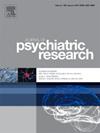精神分裂症患者冲动性降低:来自自我报告和行为测量的证据
IF 3.7
2区 医学
Q1 PSYCHIATRY
引用次数: 0
摘要
冲动性有助于精神分裂症患者的不良预后,并在诊断过程中发挥重要作用。然而,冲动性可以用多种方式来衡量,之前的研究对其与积极和消极症状的关系得出了不同的结果。为了解决这个问题,我们控制了其他变量(例如教育水平),并利用各种代表性的冲动性测量,包括Barratt冲动性量表(BIS-11)、延迟贴现任务(DDT)、概率贴现任务(PDT)和气球模拟风险任务(BART),来评估SZ患者的冲动性及其与症状的关系。研究结果表明,除了概率贴现任务外,所有其他测量都一致显示SZ患者的冲动性降低。此外,冲动性预测了SZ症状的严重程度:自我报告的冲动性和情绪调节困难预测了阳性症状,而DDT表现和性别预测了阴性症状。这些结果强调了在SZ中多维冲动性评估的重要性,不同的冲动性特征与症状维度存在差异,这可能指导症状特异性干预策略。本文章由计算机程序翻译,如有差异,请以英文原文为准。
Decreased impulsivity in Schizophrenia: Evidence from self-report and behavioral measures
Impulsivity contributes to deleterious outcomes among schizophrenia (SZ) patients, and it plays an important role in the diagnostic process. However, impulsivity can be measured in a variety of ways, and previous research has yielded mixed results regarding its relationship with positive and negative symptoms. To address this, we controlled for additional variables (e.g., educational level) and utilized various representative impulsivity measures, including the Barratt Impulsiveness Scale (BIS-11), delay discounting task (DDT), probability discounting task (PDT), and balloon analogue risk task (BART), to assess impulsivity in SZ patients and its association with symptoms. Findings indicated that, except for the probability discounting task, all other measures consistently demonstrated reduced impulsivity in SZ patients. Additionally, impulsivity predicted the severity of SZ symptoms: self-reported impulsivity and emotional regulation difficulties predicted positive symptoms, whereas DDT performance and gender predicted negative symptoms. These results highlight the importance of multidimensional impulsivity assessment in SZ, with distinct impulsivity profiles differentially associated with symptom dimensions, which may guide symptom-specific intervention strategies.
求助全文
通过发布文献求助,成功后即可免费获取论文全文。
去求助
来源期刊

Journal of psychiatric research
医学-精神病学
CiteScore
7.30
自引率
2.10%
发文量
622
审稿时长
130 days
期刊介绍:
Founded in 1961 to report on the latest work in psychiatry and cognate disciplines, the Journal of Psychiatric Research is dedicated to innovative and timely studies of four important areas of research:
(1) clinical studies of all disciplines relating to psychiatric illness, as well as normal human behaviour, including biochemical, physiological, genetic, environmental, social, psychological and epidemiological factors;
(2) basic studies pertaining to psychiatry in such fields as neuropsychopharmacology, neuroendocrinology, electrophysiology, genetics, experimental psychology and epidemiology;
(3) the growing application of clinical laboratory techniques in psychiatry, including imagery and spectroscopy of the brain, molecular biology and computer sciences;
 求助内容:
求助内容: 应助结果提醒方式:
应助结果提醒方式:


